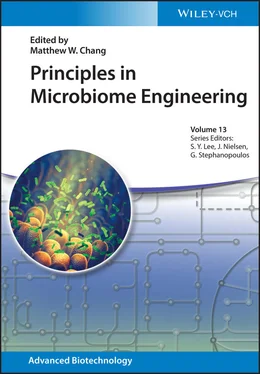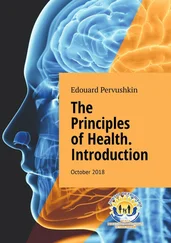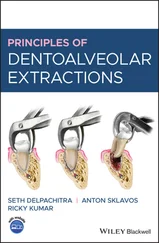Principles in Microbiome Engineering
Здесь есть возможность читать онлайн «Principles in Microbiome Engineering» — ознакомительный отрывок электронной книги совершенно бесплатно, а после прочтения отрывка купить полную версию. В некоторых случаях можно слушать аудио, скачать через торрент в формате fb2 и присутствует краткое содержание. Жанр: unrecognised, на английском языке. Описание произведения, (предисловие) а так же отзывы посетителей доступны на портале библиотеки ЛибКат.
- Название:Principles in Microbiome Engineering
- Автор:
- Жанр:
- Год:неизвестен
- ISBN:нет данных
- Рейтинг книги:5 / 5. Голосов: 1
-
Избранное:Добавить в избранное
- Отзывы:
-
Ваша оценка:
- 100
- 1
- 2
- 3
- 4
- 5
Principles in Microbiome Engineering: краткое содержание, описание и аннотация
Предлагаем к чтению аннотацию, описание, краткое содержание или предисловие (зависит от того, что написал сам автор книги «Principles in Microbiome Engineering»). Если вы не нашли необходимую информацию о книге — напишите в комментариях, мы постараемся отыскать её.
Provides an overview of the techniques and applications insight into the complex composition and interactions of microbiomes Principles in Microbiome Engineering
Principles in Microbiome Engineering
Principles in Microbiome Engineering — читать онлайн ознакомительный отрывок
Ниже представлен текст книги, разбитый по страницам. Система сохранения места последней прочитанной страницы, позволяет с удобством читать онлайн бесплатно книгу «Principles in Microbiome Engineering», без необходимости каждый раз заново искать на чём Вы остановились. Поставьте закладку, и сможете в любой момент перейти на страницу, на которой закончили чтение.
Интервал:
Закладка:
208 208 Gerasimidis, K., Bertz, M., Hanske, L., et al. (2014). Decline in presumptively protective gut bacterial species and metabolites are paradoxically associated with disease improvement in pediatric Crohn's disease during enteral nutrition. Inflamm. Bowel Dis. 20 (5): 861–871.
209 209 Quince, C., Ijaz, U.Z., Loman, N., et al. (2015). Extensive modulation of the fecal metagenome in children with Crohn's disease during exclusive enteral nutrition. Am. J. Gastroenterol. 110 (12): 1718–1730.
210 210 Coburn, L.A., Gong, X., Singh, K., et al. (2012). L‐arginine supplementation improves responses to injury and inflammation in dextran sulfate sodium colitis. PLoS One 7 (3): e33546.
211 211 Xue, H., Sufit, A.J.D., and Wischmeyer, P.E. (2011). Glutamine therapy improves outcome of in vitro and in vivo experimental colitis models. JPEN J Parenter Enteral Nutr. 35 (2): 188–197.
212 212 Silveira, A.L.M., Ferreira, A., de Oliveira, M.C., et al. (2017). Preventive rather than therapeutic treatment with high fiber diet attenuates clinical and inflammatory markers of acute and chronic DSS‐induced colitis in mice. Eur. J. Nutr. 56 (1): 179–191.
213 213 Singh, N., Gurav, A., Sivaprakasam, S., et al. (2014). Activation of Gpr109a, receptor for niacin and the commensal metabolite butyrate, suppresses colonic inflammation and carcinogenesis. Immunity 40 (1): 128–139.
214 214 Maslowski, K., Vieira, A., Ng, A., et al. (2009). Regulation of inflammatory responses by gut microbiota and chemoattractant receptor GPR43. Nature 461 (7268): 1282–1286.
215 215 Schatzkin, A., Mouw, T., Park, Y., et al. (2007). Dietary fiber and whole‐grain consumption in relation to colorectal cancer in the NIH‐AARP diet and health study. Am. J. Clin. Nutr. 85 (5): 1353–1360.
216 216 Park, Y., Hunter, D.J., Spiegelman, D., et al. (2005). Dietary fiber intake and risk of colorectal cancer ‐ a pooled analysis of prospective cohort studies. JAMA 294 (22): 2849–2857.
217 217 Bingham, S.A., Day, N.E., and Luben, R., et al. (2003). Dietary fibre in food and protection against colorectal cancer in the European Prospective Investigation into Cancer and Nutrition (EPIC): an observational study (vol 361, pg 1496, 2003). Lancet 362 (9388): 1000.
218 218 Ahuja, N., Easwaran, H., and Baylin, S.B. (2014). Harnessing the potential of epigenetic therapy to target solid tumors. J. Clin. Invest. 124 (1): 56–63.
219 219 Aminov, R.I., Walker, A.W., Duncan, S.H., et al. (2006). Molecular diversity, cultivation, and improved detection by fluorescent in situ hybridization of a dominant group of human gut bacteria related to Roseburia spp. or Eubacterium rectale. Appl. Environ. Microbiol. 72 (9): 6371–6376.
220 220 Hold, G.L., Schwiertz, A., Aminov, R.I., et al. (2003). Oligonucleotide probes that detect quantitatively significant groups of butyrate‐producing bacteria in human feces. Appl. Environ. Microbiol. 69 (7): 4320–4324.
221 221 Barcenilla, A., Pryde, S.E., Martin, J.C., et al. (2000). Phylogenetic relationships of butyrate‐producing bacteria from the human gut. Appl. Environ. Microbiol. 66 (4): 1654–1661.
222 222 Schwiertz, A., Le Blay, G., and Blaut, M. (2000). Quantification of different Eubacterium spp. in human fecal samples with species‐specific 16S rRNA‐targeted oligonucleotide probes. Appl. Environ. Microbiol. 66 (1): 375–382.
223 223 Li, Q.R., Ding, C.J., Meng, T., et al. (2017). Butyrate suppresses motility of colorectal cancer cells via deactivating Akt/ERK signaling in histone deacetylase dependent manner. J. Pharmacol. Sci. 135 (4): 148–155.
224 224 Chen, J.Z. and Vitetta, L. (2018). Inflammation‐modulating effect of butyrate in the prevention of colon cancer by dietary fiber. Clin. Colorectal Cancer 17 (3): E541–E544.
225 225 Schwab, J.M., Chiang, N., Aruta, M., and Serhan, C.N. (2007). Resolvin E1 and protectin D1 activate inflammation‐resolution programmes. Nature 447 (7146): 869–874.
226 226 Macfarlane, S. and Macfarlane, G.T. (2003). Regulation of short‐chain fatty acid production. Proc. Nutr. Soc. 62 (1): 67–72.
227 227 Li, F., Hullar, M.A.J., Schwarz, Y., and Lampe, J.W. (2009). Human gut bacterial communities are altered by addition of cruciferous vegetables to a controlled fruit‐ and vegetable‐free diet. J. Nutr. 139 (9): 1685–1691.
228 228 Ho, C.L., Tan, H.Q., Chua, K.J., et al. (2018). Engineered commensal microbes for diet‐mediated colorectal‐cancer chemoprevention. Nat. Biomed. Eng. 2 (1): 27–37.
229 229 McCoy, A.N., Araújo‐Pérez, F., Azcárate‐Peril, A., et al. (2013). Fusobacterium is associated with colorectal adenomas. PLoS One 8 (1): e53653.
230 230 Castellarin, M., Warren, R.L., Freeman, J.D., et al. (2012). Fusobacterium nucleatum infection is prevalent in human colorectal carcinoma. Genome Res. 22 (2): 299–306.
231 231 Kostic, A.D., Gevers, D., Pedamallu, C.S., et al. (2012). Genomic analysis identifies association of Fusobacterium with colorectal carcinoma. Genome Res. 22 (2): 292–298.
232 232 Dejea, C.M., Wick, E.C., Hechenbleikner, E.M., et al. (2014). Microbiota organization is a distinct feature of proximal colorectal cancers. Proc. Natl. Acad. Sci. U.S.A. 111 (51): 18321–18326.
233 233 Al‐Hassi, H.O., Ng, O., and Brookes, M. (2018). Tumour‐associated and non‐tumour‐associated microbiota in colorectal cancer. Gut 67 (2): 395.
234 234 Yang, Z. and Ji, G. (2019). Fusobacterium nucleatum‐positive colorectal cancer. Oncol. Lett. 18 (2): 975–982.
235 235 Mehta, R.S., Nishihara, R., Cao, Y., et al. (2017). Association of dietary patterns with risk of colorectal cancer subtypes classified by Fusobacterium nucleatum in tumor tissue. JAMA Oncol. 3 (7): 921–927.
236 236 Martin, C.R., Osadchiy, V., Kalani, A., and Mayer, E.A. (2018). The brain‐gut‐microbiome axis. Cell. Mol. Gastroenterol. Hepatol. 6 (2): 133–148.
237 237 Luna, R.A., Savidge, T.C., and Williams, K.C. (2016). The brain‐gut‐microbiome axis: what role does it play in autism spectrum disorder? Curr. Dev. Disord. Rep. 3 (1): 75–81.
238 238 Vuong, H.E. and Hsiao, E.Y. (2017). Emerging roles for the gut microbiome in autism spectrum disorder. Biol. Psychiatry 81 (5): 411–423.
239 239 Ghaisas, S., Maher, J., and Kanthasamy, A. (2016). Gut microbiome in health and disease: linking the microbiome‐gut‐brain axis and environmental factors in the pathogenesis of systemic and neurodegenerative diseases. Pharmacol. Ther. 158: 52–62.
240 240 Jiang, C., Li, G., Huang, P., et al. (2017). The gut microbiota and Alzheimer's disease. J. Alzheimers Dis. 58: 1–15.
241 241 Peng, B., Xue, G., Xu, D., et al. (2019). Expression and purification of recombinant serine protease domain of human coagulation factor XII in Pichia pastoris. Biosci. Biotechnol. Biochem. 83 (10): 1815–1821.
242 242 Norman, K.L., Shively, C.A., De la Rocha, A.J., et al. (2018). Inositol polyphosphates regulate and predict yeast pseudohyphal growth phenotypes. PLoS Genet. 14 (6): e1007493.
243 243 McElhanon, B.O., McCracken, C., Karpen, S., and Sharp, W.G. (2014). Gastrointestinal symptoms in autism spectrum disorder: a meta‐analysis. Pediatrics 133 (5): 872–883.
244 244 Parracho, H.M., Bingham, M.O., Gibson, G.R., and Mccartney, A. (2005). Differences between the gut microflora of children with autistic spectrum disorders and that of healthy children. J. Med. Microbiol 54 (10): 987–991.
245 245 Finegold, S.M., Molitoris, D., Song, Y., et al. (2002). Gastrointestinal microflora studies in late‐onset autism. Clin. Infect. Dis. 35 (Suppl. 1): S6–S16.
246 246 Song, Y., Liu, C., and Finegold, S.M. (2004). Real‐time PCR quantitation of clostridia in feces of autistic children. Appl. Environ. Microbiol. 70 (11): 6459–6465.
Читать дальшеИнтервал:
Закладка:
Похожие книги на «Principles in Microbiome Engineering»
Представляем Вашему вниманию похожие книги на «Principles in Microbiome Engineering» списком для выбора. Мы отобрали схожую по названию и смыслу литературу в надежде предоставить читателям больше вариантов отыскать новые, интересные, ещё непрочитанные произведения.
Обсуждение, отзывы о книге «Principles in Microbiome Engineering» и просто собственные мнения читателей. Оставьте ваши комментарии, напишите, что Вы думаете о произведении, его смысле или главных героях. Укажите что конкретно понравилось, а что нет, и почему Вы так считаете.












